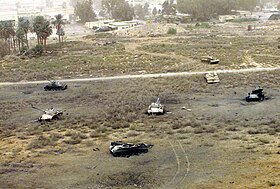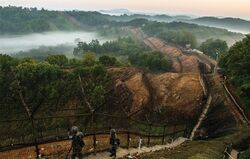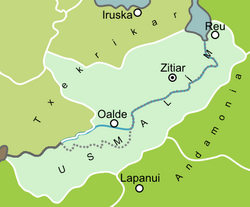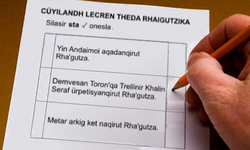War of the Eastern Velar
| War of the Eastern Velar | |||||||||
|---|---|---|---|---|---|---|---|---|---|
| Part of the Usma Cold War | |||||||||
 Abandoned Andamonian tanks in eastern Txekrikar | |||||||||
| |||||||||
| Belligerents | |||||||||
|
| ||||||||
| Commanders and leaders | |||||||||
|
|
| ||||||||
| Strength | |||||||||
|
112,000 men 50 Tsukumo A18Ts 1 carrier 12 frigates |
275,000–300,000 men 400 CC-58s | ||||||||
| Casualties and losses | |||||||||
|
Killed: 1,348 Missing/captured: 12 Wounded: 10,516 |
Killed: 7,169 Missing/captured: 43 Wounded: 24,658 | ||||||||
The War of the Eastern Velar (Trellinese: Fyruz Velarka Sarzig; Andamonian: Lúsha ha'Velarú Catamoú), known initially as the Trophy Ports Restoration and dubbed by some sources the Trellinese invasion of Andamonia (or, conversely, the Andamonian invasion of Trellin), was a war fought in late 2014 between Trellin and Andamonia. It was provoked by the recapture of Rha'gutza and Khorvu, occupied by Andamonia almost continuously since the Trellinese Civil War in the 1890s, by a Trellinese squadron on 16 September 2014. Andamonia immediately retaliated with an invasion of Txekrikar in a bid to recapture the region of the Usmalím it had conquered in the Great Astyrian War and lost during the Trophy Wars.
Fighting quickly came to centre around the Txekri city of Zitiar, previously the scene of intense urban warfare in the Trophy Wars. Lacking the resources for a protracted war and faced with a technologically superior opponent, the successes brought by Andamonia's initial numerical superiority did not last and its military was on the retreat within a month. Trellinese and Txekri forces advanced to the eastern frontier of the Usmalím, occupying the territory and subduing local resistance as naval and air support targetted bases along the Andamonian coast. The already rising discontent among the Andamonian people was exacerbated by the military's disgrace and the realisation that the war was effectively unwinnable. Riots soon broke out in the capital, Zadé Axochizin, and rebel insurgencies stepping up their campaigns within Andamonia forced emperor Amahuiz Tlacapilzi to surrender in mid-November.
After the capitulation of the Andamonian emperor, the nation still remained rife with internal division. Conflict continued to escalate throughout most of the empire, until Amahuiz was forced to flee the country. Local and provincial governments variously attempted to subdue the militias or secede from the empire, with some claiming greater or lesser degrees of autonomy from the collapsing federal government. This began a new phase of conflict labelled the War of Integrity, in which the Trellinese government of Azara V was asked to intervene in support of Andamonian imperial authority. One result of these wars was the abdication of Emperor Amahuiz, who instituted the Andamonian Third Republic on his resignation.
Background
The Trophy Ports are a group of historically-important trading centres around the Sea of Velar, mostly founded and controlled by the Trellinese Empire. In the 1890s, during the Trellinese Civil War, Andamonian Republican forces invaded the three eastern Trophy Ports, Mintra, Rha'gutza and Khorvu. Though repulsed at Mintra by Namijan troops, they successfully occupied Rha'gutza and Khorvu as the Trellinese military was preoccupied in the west and unable to react.
20th century
From 1913 to February 2014, Trellin was in a state of self-imposed isolation with only minimal contact with the rest of Astyria, conducted primarily by the empire's sovereign protectorates. It remained almost totally uninvolved in the Great Astyrian War in which its protectorates Arimathea and Txekrikar were at war with Andamonia. It was at this time that Andamonia occupied the Txekri Usmalím, a prosperous border region around the river Baira which had previously been contested in the 1870s.

The list of Trellinese grievances against Andamonia continued to grow until 1931, when King Amadar IV of Trellin deployed large numbers of warships to retake Rha'gutza and Khorvu, the first act of the Trophy Wars. Though they were at first successful, Andamonia's retaliation drove the Trellinese back out, with the focus of the war moving to Namija and Txekrikar. Andamonian ground forces advanced quickly across Namija but were worn down by Trellin's scorched-earth retreat and finally forced to withdraw in 1934. The Usmalím and Txekrikar remained a theatre of protracted guerrilla and urban warfare throughout 1935, despite a Trellinese attempt to break the stalemate by advancing on the Andamonian capital. Naval support finally turned the war in Trellin's favour and their assault from two fronts forced Andamonia to call for a ceasefire. Negotiations failed, however, as neither side proved willing to surrender its occupied territories, but with their economies devastated neither empire chose to renew the war. In the aftermath, Trellin remained officially silent, though its intelligence agencies and those of Andamonia engaged in what became known as the Usma Cold War. The de facto border in the Usmalím between Txekrikar and Andamonia became heavily militarised and saw intermittent skirmishes over the following decades.
Trophy Port crisis
For the first few decades of post-war occupation, the Trophy Ports' inhabitants (called Khalitans) attempted to resist Andamonian government with regular riots but eventually settled down to passive aggression as the second generation took over. From 2005 onward, the military presence in the two cities increased by almost 49%, creating an increasingly militant atmosphere in the area.[1] In early 2014, then, the situation escalated quickly to crisis levels as DramFreight, the Andamonian supplier of food shipments to Rha'gutza and Khorvu, refused to continue to honour its contract due to expenses.[2] Riots broke out almost immediately, initially protesting the impending food shortages but soon taking on the character of an independence movement. As the situation escalated in the Trophy Ports, the Dangish government imposed emergency restrictions on travel into and out of both Rha'gutza and Khorvu.[3] On 11 February, the governors of the two cities imposed curfews and martial law which were at first obeyed, but, organised by the ethnic Trellinese members of the local council, the Rha'gutzan Khalitans took up arms two days later and barricaded themselves into the city's courthouse, occasionally exchanging small arms fire with the Andamonian garrison.
Letter to Mahrim II, dated 13 February 2014.[4]
The Rha'gutzan rebels staged a trial by proxy of the statue of Hanrel Mata, the long-dead Andamonian conqueror of the Trophy Ports, finding him guilty of genocide and sentencing the statue to "death by drowning."[1] Shortly thereafter, they wrote a communal letter to King Mahrim II of Trellin petitioning for reentry to the empire.[5] Four days later, the king responded to accept the Khalitan petition, after formally declaring an end to the Trellinese period of isolationism that had been in place for.[6] Another seven months of general unrest elapsed before Trellin issued a 48-hour ultimatum to the Andamonian government on 12 September, demanding their withdrawal from the Trophy Ports and the return of Rha'gutza and Khorvu to Trellinese administration.[7]
Dangish intervention
The Dangish Empire, which bordered Andamonia's Trophy Ports and had a vested interest in maintaining a stable Sea of Velar, stepped in to criticise the Trellinese ultimatum which it regarded as unacceptable. It insisted on the obligation to allow the Khalitans self-determination;[8] Trellin responded that Andamonia had blatantly ignored this obligation and would never grant the referendum demanded by the Dangish.[9] The Dangish agreed to allow Trellin to take over temporary administration of the Trophy Ports on the express condition that a referendum be held as soon as possible.[10]
In a session of the Grand Assembly of Andamonia, Emperor Amahuiz gave a speech denouncing "Trellinese imperialism and irredentism" and refused to surrender the Trophy Ports or the eastern Usmalím.[11] In Martheqa, Trellinese politicians claimed this as evidence that Andamonia would not hold referenda and that they would have to be held by Trellin instead.
Progress of the war
Reoccupation of the Trophy Ports
The day before Emperor Amahuiz's speech, on 15 September, a squadron of Trellinese frigates was deployed east from Mintra under Admiral Tarmüz Siveka with orders to secure Rha'gutza and Khorvu.[12] They entered the harbour of Rha'gutza at about midnight on the 16th and requested the Andamonians' surrender or withdrawal. On orders from Governor Iizok Nethil, the port's defensive gun batteries opened fire. The Trellinese ships returned fire, quickly neutralising first the New Battery, at 00:27, and then the Old Battery at 00:29. The marine complement aboard the frigates subsequently disembarked to take over key points on the waterfront and, met with only minor resistance, occupied the council hall by 00:45. The batteries soon followed, as did other strategic points throughout the city despite fighting on the quays, and at 1:03 a.m. the government officially surrendered.[13]
At 6:21 a.m., just before sunrise, three of the five Trellinese ships departed for Khorvu, arriving at about 2:24 p.m.. Governor Azanj Timaloc radioed the ships to offer his surrender, and Trellinese troops and representatives disembarked to replace the Andamonian garrison. A sixth frigate was deployed to Iruska, Txekrikar's second city and main port.
Andamonian invasion of Txekrikar
The immediate Andamonian response was to deploy its ground forces in the eastern Usmalím across the Baira river and invade Txekrikar, with tanks and other vehicles moving out from military bases at 7:54 a.m. on the 17th. Amphibious assault equipment, which had been stockpiled in preparation for a potential war with Trellin, was used to transport roughly four hundred CC-58 tanks, as well as rocket artillery and other support vehicles. The Trellinese air force hastily scrambled its recently-purchased Tsumako A18Ts to intercept the Andamonian deployment. Concurrent with the Andamonian invasion was an official statement denouncing Trellin's "continued aggression" and asserting that Andamonia's own actions were purely in self defense.[14] Ground forces in the Txekri Guard reacted quickly to resist the invasion, with the 3rd Usma Regiment gaining control over most of Zitiar, a key crossing point on the Baira, well in advance of the arrival of Andamonian motorised divisions in city in the afternoon of the 16th. A sustained period of intense urban warfare followed between Txekri and Andamonian troops in Zitiar, as the Txekri units stationed in the city lost ground incrementally to the far greater Andamonian numbers, and on the 22nd combat spread rapidly from its confined hotspots to encompass almost the entire length of the Baira from Oalde to the coast. This left the 3rd Usma without the prospect of support, while it continued to take heavy casualties in the face of a sustained onslaught. Large portions of Zitiar, particularly the eastern side which had remained decrepit since the Trophy Wars, were reduced to rubble as Andamonian tanks and artillery attempted to root out localised pockets of resistance. Aerial support returned in the afternoon on 4 October, as Trellinese fighter jets out of Baxa made strikes on the Andamonian units in Zitiar and Oalde, turning the tide of battle definitively against Andamonia.[15]
As officials in Zadé Axochizin and Rehahu (Reu) conceded their forces in the Usmalím were outmatched, the Andamonian military began its hasty withdrawal from the Baira valley. Trellinese aircraft operating out of bases on Kerypa and from an aircraft carrier in the Gulf of Andamonia conducted a series of tactical strikes on facilities near Pathatl and Teraxi Yú. Retreating forces in the eastern Usmalím found themselves cut off from air support and in many cases chose to abandon their armour, leaving behind tanks in the marshes.[16]
Trellinese counteroffensive and stalemate
As Andamonian troops withdrew, the void was filled by the advancing ground forces of the Sidereal Crown. Local militias took up the resistance against the Trellinese counteroffensive, and its progress across the Baira marshes was slow. The port city of Rehahu was occupied on the 22nd, while the air force continued to target bases further inland. The militias' success was more limited in recapturing Rehahu and other settlements as they fell to encroaching Trellinese forces, unsupported by government troops. The official Andamonian resistance nevertheless continued at sea, as its navy engaged the Trellinese warships off the coast as they withdrew landward. As the Trellinese consolidated their hold on the Usmalím, they awaited a ceasefire or surrender from Zadé Axochizin. When this was not forthcoming by the end of October the navy and marines occupied Getús and Uushen in preparation for a possible invasion of the Olahu Peninsula.[16]
Andamonian surrender
As the imperial military continued its retreat from the front and attempted to maintain order in Andamonia's cities, media outlets in Andamonia acquired leaked statistics on casualties which painted a stark picture of the ongoing defeat. The public finally turned decisively against its emperor, and severe internal division hampered the efforts of central government to maintain order.[17][16] Government forces offered a weak resistance against the militias that had turned on them but failed to make any move to retake the lands held by Trellin or to counter Trellinese attacks on naval and air bases. Andamonia's First Speaker, Mocat Xekomo, fled the country during this time. On 18 November, Emperor Amahuiz publicly ordered the military to stand down, calling on Trellin to join Andamonia in a lasting ceasefire as he offered his empire's surrender:
People of Trellin, to you we extend a hand in contrition and, I hope, reconciliation. Our - indeed, my - stubborn arrogance has cost so many lives, all so needlessly. Let this moment be the end of this war and the end of all hostility between our peoples. From this point forward I order our soldiers, all our soldiers, wherever they may be, to stand down, and I humbly request that you, the Trellinese, join us in ushering in a lasting ceasefire and peace. I come before you as just some errant fool to a great and proud nation whom I have wronged. I will not have it said that I am too proud to yield. I yield now.[17]
Reunification
Under the new Trellinese administration, a pair of simultaneous referenda were held in Rha'gutza and Khorvu on 20 September. The referendum offered voters - out of an electorate consisting of all Khalitan residents, regardless of citizenship status or nationality - three choices: to remain part of Andamonia, to rejoin the Trellinese province of the Trophy Ports or to become an independent state. At dawn, hours before voting booths were to open, long queues had already formed outside polling stations.[18] At the end of the day, an estimated 81.4% turnout was reported as an average across all constituencies, and exit polls indicated as much as a 90% majority in favour of reunification. When results were announced on 22 September, nearly 85% of votes were for rejoining Trellin, with roughly 11% voting for independence and the remainder for the status quo.[19]
Reactions
In both Liberty Square, Rha'gutza, and Prince of Baxa Place, Khorvu, the announcement of the referendum results was met with cheering and applause from the "jubilant crowds". Observers, mainly from Étlaurlande, praised the transparency of the referendum,[18] though some political watchdog agencies expressed mild concern over how the ballots were worded. Trellin's Mahrim II, as well as the governments of the empire's protectorates, all expressed delight and congratulations towards the Khalitans.
Andamonia's reactions were less pleased, with its emperor denouncing the referendum as false and invalid, to the outrage of Khalitan and Trellinese politicians.[19] A letter from Emperor Amahuiz read out before the Grand Assembly accused the Dangish and Étlaurlandic governments of complicity in "allowing Trellinese tyrants to overthrow rightful rule" with what the Andamonian government regarded as an illegally-held referendum. A political analyst from Zacatla Imperial University accused the Khalitan Referendum Commission of attempting to rig the plebiscite by using ambiguous wording to deter a vote against reunification.[20]
International
 Caprica: The Caprican government urged calm at the outbreak of the conflict, repeating its calls for peace after each major event. President Kenway invited the Andamonian ambassador and the Kur'zheti consul for the Ethlorek Community to negotiate a ceasefire, although talks fell through without making progress.
Caprica: The Caprican government urged calm at the outbreak of the conflict, repeating its calls for peace after each major event. President Kenway invited the Andamonian ambassador and the Kur'zheti consul for the Ethlorek Community to negotiate a ceasefire, although talks fell through without making progress. Dangish Empire: Dangish officials present at polling confirmed the validity of the referenda, stating that they were "fairly conducted" and "in keeping with Imperial standards of democracy." First Lord of the Treasury, Lord Scylla, congratulated the Khalitans on their democratic decision and phoned King Mahrim to offer personal congratulation on a relatively peaceful resolution. Plans were also announced to lift the earlier restrictions on travel to the Trophy Ports.[21][3] Nathaniel Osborne also announced during Second Lord's Questions that he had asked the Sidereal Crown to restrict its deployments to the Trophy Ports until Andamonia had become less volatile.[22]
Dangish Empire: Dangish officials present at polling confirmed the validity of the referenda, stating that they were "fairly conducted" and "in keeping with Imperial standards of democracy." First Lord of the Treasury, Lord Scylla, congratulated the Khalitans on their democratic decision and phoned King Mahrim to offer personal congratulation on a relatively peaceful resolution. Plans were also announced to lift the earlier restrictions on travel to the Trophy Ports.[21][3] Nathaniel Osborne also announced during Second Lord's Questions that he had asked the Sidereal Crown to restrict its deployments to the Trophy Ports until Andamonia had become less volatile.[22] Berique: President of Berique [] offered a guarded comment on the referendum outcome, praising Trellin for defending the "integrity of its inheritance" in a remark that analysts believe was calculated to avoid encouraging separatist movements on the west coast of the republic.
Berique: President of Berique [] offered a guarded comment on the referendum outcome, praising Trellin for defending the "integrity of its inheritance" in a remark that analysts believe was calculated to avoid encouraging separatist movements on the west coast of the republic.
Aftermath
Fragmentation of the Andamonian Empire

After the official surrender, opposition to central government remained high in Andamonia. Despite attempts to suppress armed resistance, the national military bled manpower as desertion rates soared. Protests in the cities were briefly suspended amid an air of general relief at the end of the actual war, but as it became clear that the ongoing rebellions were not coming to an end the riots began once again. Protesters and rioters soon marched on the palace in Zadé Axochizin. On 8 December, the emperor fled the country, taking refuge in Paradise City. He returned soon afterward, however, and moved to his residence in Cevrazu which had become the centre of loyalist administration.[23] The War of Integrity, as the struggle by imperial forces to maintain the authority of central government became known, saw Amahuiz eventually appeal to the government of Azara V for assistance in August 2015.[24] Despite continued opposition from militias and secessionists, concentrated chiefly in the north, east and extreme south, Trellinese support reversed the steady losses of territory to rebel sects.[25]
The Andamonian economy was devastated by the continual war and rebellion. The collapse of first central and then local government control in peripheral areas and on the Olahu Peninsula led to a sharp fall in legitimate business. Recorded employment plummetted from 56.3% to below 40% by late July. In bids to counter this fall in trade, Trellinese authorities at the Straits of Jajich relaxed traffic monitoring and the Dangish government urged for lowering of trade barriers in Trellin and Andamonia. A consequence of these factors was a significant rise in illegal and black market activities in Andamonia, including drug production and drug-running. A Cadenzan naval vessel intercepted a cocaine shipment with an estimated street value of $60 million in July 2015, reflective of the decaying Andamonian economy.[26]
Reunification of the Usmalím
As part of his surrender, Emperor Amahuiz pledged personally to restore the eastern Usmalím to "legitimate Txekri governance".[17] Over the next few months, he and Mahrim II arranged for a transitional government in the province to oversee the process of replacing the legal system in the eastern Usmalím with the Txekri legal code. The administration under governor Tantei Sitamui cooperated closely with Prince Eshkan ha'Roita's government, complying with their requests and requirements. The tenure of this transitional government came to an end at 12:00 AST on 3 February 2016, with the Txekri prince and Andamonian governor meeting in Reu (formerly Rehahu) for the formal handover of the territory. The reunification of Txekrikar, over ninety years after it was divided, met with enthusiastic celebration from the overwhelming majority of Txekri people.[23]
Public opinion on the war
International opinion and government responses
 Aquitayne: Aquitayne issued a terra nullius stare decisis ("Land of none; to stand by the decided things") decree at the onset of the conflict. This decree helped to legitimise the Sidereal Crown's actions, as Aquitayne was the first nation to openly support and ratify legislation in support of their actions. The Aquitaynian Parliament later issued a concurrent translatio imperii ("transfer of rule"), which formally recognized the territorial sovereignty of Txekrikar under the laws and jurisdiction of the Sidereal Crown.
Aquitayne: Aquitayne issued a terra nullius stare decisis ("Land of none; to stand by the decided things") decree at the onset of the conflict. This decree helped to legitimise the Sidereal Crown's actions, as Aquitayne was the first nation to openly support and ratify legislation in support of their actions. The Aquitaynian Parliament later issued a concurrent translatio imperii ("transfer of rule"), which formally recognized the territorial sovereignty of Txekrikar under the laws and jurisdiction of the Sidereal Crown. Romberg: As the war drew to a close, the Rombergian government and Kaiser stated that they would closely monitor the situation and consider the prospect of sending humanitarian aid or peacekeeping forces as needed.[27]
Romberg: As the war drew to a close, the Rombergian government and Kaiser stated that they would closely monitor the situation and consider the prospect of sending humanitarian aid or peacekeeping forces as needed.[27]
Andamonian opinion
The war was unpopular from the outset within Andamonia, and by mid-October there were anti-war protests in most major cities, devolving into riots as local and national government cracked down on marches and rallies. In addition to backing the anti-war cause, many local militias seized the opportunity to make demands of the emperor for further concessions. Several took up arms against government forces, beginning a period of civil war.[28] Other political groups called for Emperor Amahuiz's abdication, or attempted to secede altogether,[16] as in the case of the Ubeylatl which broke away on 3 November. Trellinese involvement in restoring peace in the aftermath of the war was viewed with distrust, as conspiracy theorists and others asserted that it was either a renewed effort to conquer Andamonia or "a ploy to keep Trellin's ancient rival as a permanent underdog"; nevertheless, loyalist and Trellinese successes against the rebels saw calls for Amahuiz to abdicate more or less cease.[25]
Trellinese opinion
References
- ↑ 1.0 1.1 Wright & Apollo, "Trophy Ports, Trellin, Andamonia, and Southern Astyria", 16 February 2014. Retrieved 20 November 2015.
- ↑ http://forum.nationstates.net/viewtopic.php?p=18799084#p18799084
- ↑ 3.0 3.1 "Emergency restrictions on Rha'gutza - markets buoyed", The Intelitza Times, 23 September 2014. Retrieved 15 May 2015.
- ↑ Araguzi, Modriq, Brefnid, Txerig, ti Ormen, Mevala, Porgenl, Ésanna, Edarthesin, Khal and Crennihi, Larand, Councillors of Rha'gutza to Mahrim II, 13 February 2014. Accessed 19 July 2018.
- ↑ http://forum.nationstates.net/viewtopic.php?p=18827489#p18827489
- ↑ Mahrim II, Mahrim II to the Trellinese people of Rha'gutza and Khorvu, 17 February 2014. Accessed 10 March 2016.
- ↑ http://forum.nationstates.net/viewtopic.php?p=21714680#p21714680
- ↑ http://forum.nationstates.net/viewtopic.php?p=21718187#p21718187
- ↑ http://forum.nationstates.net/viewtopic.php?p=21720710#p21720710
- ↑ http://forum.nationstates.net/viewtopic.php?p=21727839#p21727839
- ↑ http://forum.nationstates.net/viewtopic.php?p=21758344#p21758344
- ↑ http://forum.nationstates.net/viewtopic.php?p=22930267#p22930267
- ↑ http://forum.nationstates.net/viewtopic.php?p=22981469#p22981469
- ↑ http://forum.nationstates.net/viewtopic.php?p=23231931#p23231931
- ↑ http://forum.nationstates.net/viewtopic.php?p=24590021#p24590021
- ↑ 16.0 16.1 16.2 16.3 Resuna, Avureg, "It's over", The Sidereal Herald, 18 November 2014. Retrieved on 16 July 2015.
- ↑ 17.0 17.1 17.2 http://forum.nationstates.net/viewtopic.php?p=26554971#p26554971
- ↑ 18.0 18.1 Silmerin, Taihan, "Trophy Ports reunited", The Sidereal Herald, 22 September 2014. Retrieved on 13 May 2015.
- ↑ 19.0 19.1 "Referendum results come in", Trellinese Broadcasting Corporation, 23 September 2014. Retrieved on 13 May 2015.
- ↑ Pilezar, Cohmani, "Emperor denounces Trellin » Trophy Ports referenda "shambolic deceptions"", Cevrazu/24, 23 September 2014. Retrieved 13 May 2015.
- ↑ "Trophy Ports vote for Trellin - "Fairly"", The Intelitza Times, 23 September 2014. Retrieved 15 May 2015.
- ↑ http://forum.nationstates.net/viewtopic.php?p=24619782#p24619782
- ↑ 23.0 23.1 Resuna, Avureg, "The Eastern Velar: fifteen months on", The Sidereal Herald, 3 February 2016. Retrieved on 4 February 2016.
- ↑ Er'hani, Mokhra, Memorandum to Admiral Tarmüz Siveka, Mintra Naval Base: re: Naval component of Operation Flying Mynah, 24 August 2015. Retrieved on 4 May 2016.
- ↑ 25.0 25.1 Pilezar, Cohmani, "War never changes » Is Andamonia on the road to a brighter future?", Cevrazu/24, 23 April 2016. Retrieved on 4 May 2016.
- ↑ ti'Meda, Carenter, "Navy seizes Ŧ75 million in cocaine off Lemithri coast » Smuggling remains on sharp rise as an empire crumbles", Lema Examiner, 27 July 2015. Retrieved 5 November 2015.
- ↑ "Peace at Last", Imperial Rombergian News Agency, 18 November 2014. Retrieved on 5 November 2015.
- ↑ http://forum.nationstates.net/viewtopic.php?p=24892688#p24892688







